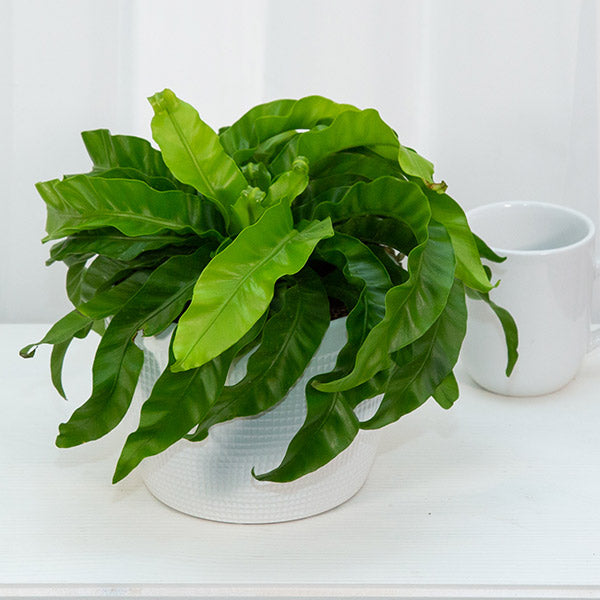Bird's Nest Fern (Asplenium nidus)
Bird's Nest Fern Plant Features
Bird's nest fern is a strikingly architectural fern for indoor or outdoor décor. Often displayed on desks and tabletops, it is a relatively small fern when young, but can reach 3 feet wide once mature. But don't worry -- this slow grower rarely becomes that large indoors.
It features lush green fronds that radiate out from a central point, creating something of a bird's nest effect (hence its common name). Its long, often slender fronds create fantastic contrast against more common houseplant fern varieties, making it a valuable addition to the home or office.
There are several varieties available. Some have relatively smooth leaves, others may have ruffled edges or crested tips. A collection of different varieties displayed together creates an impactful sight!
Buy Bird's Nest Fern
Buy it online and have it shipped fresh from our farm, direct to your door from our online plant shop. Or find it online or at your favorite local garden center from one of our retailer partners.
Bird's Nest Fern Growing Instructions
Indoors, bird's nest fern grows in low, medium, or bright light. It tolerates low light, growing much more slowly in such conditions. In Southern climates, it's best to keep this fern out of direct sun inside; in more Northern areas, it may be able to tolerate sunlight through a window, especially during the winter months.Water bird's nest fern as the top couple of inches of the potting mix dry to the touch. Thanks to its thick, almost leathery fronds, it withstands drying out better than other common fern varieties. For best appearance and performance, it's best not to let it get too thirsty. You may notice the fronds start to become slightly less shiny and a duller shade of green as it gets thirstier.
Bird's nest fern appreciates average to above-average relative humidity levels, and as such, enjoys growing in a terrarium or under a cloche in areas with dry air (particularly in winter).
You don't need to prune bird's nest fern except to remove old fronds as they age. It's natural for the oldest fronds to go yellow after time.
If you wish to fertilize your bird's nest fern, you can do so in spring and/or summer with a fertilizer formulated for use on houseplants. Follow the guidelines on the fertilizer packaging for recommended frequency and application rates.
Outdoors, bird's nest fern can be enjoyed as an annual in cold-winter areas, or as an evergreen perennial in frost-free areas. When growing it outside, a shaded spot is best. Avoid direct sun.
Bird's nest fern is an ornamental plant and not recommended for either human or animal consumption.
-
Water
Constantly moist soil
Medium water needs
-
Light
Indoors: High light
Indoors: Low light
Indoors: Medium light
Outside: Shade
-
Colors
Green
-
Special Features
Purifies the air
Super-easy to grow
Complement your Bird's Nest Fern
AnthuriumAdd a splash of color to your space by mixing the lush look of bird's nest fern with red-, pink-, purple-, orange-, or white-flowering anthuriums.
Fern, Houseplant
Accent bird's nest fern with the lacy fronds of other common selections such as Austral Gem fern or maidenhair fern.
Philodendron
Bird's nest fern looks smashing with almost every variety of philodendron. Birkin, for example, complements its form but offers contrasting variegated foliage.


